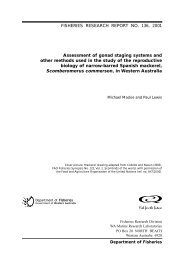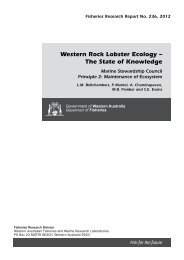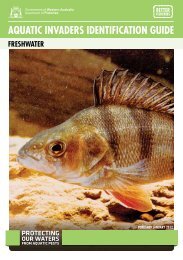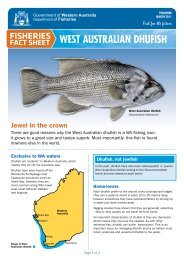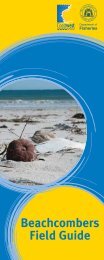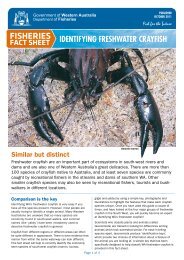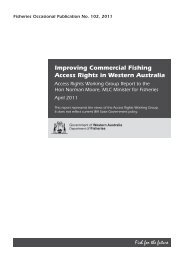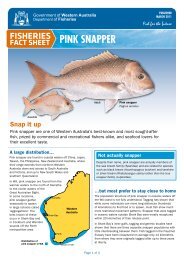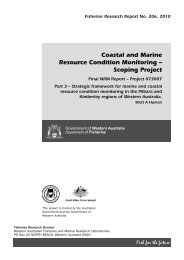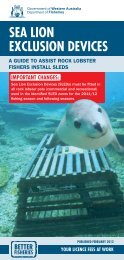DEPARTMENT OF FISHERIES ANNUAL REPORT TO THE ...
DEPARTMENT OF FISHERIES ANNUAL REPORT TO THE ...
DEPARTMENT OF FISHERIES ANNUAL REPORT TO THE ...
Create successful ePaper yourself
Turn your PDF publications into a flip-book with our unique Google optimized e-Paper software.
DISCLOSURES AND LEgAL COMPLIANCE � DETAILED kEy PERFORMANCE INDICA<strong>TO</strong>RS<br />
PERCENTAGE<br />
100%<br />
80%<br />
60%<br />
40%<br />
20%<br />
0%<br />
55%<br />
2001/02<br />
68%<br />
2002/03<br />
77%<br />
2003/04<br />
2004/05<br />
86% 86%<br />
2005/06<br />
Percentage of fisheries where<br />
catch share is known<br />
Percentage of fisheries where<br />
catch share allocation is in progress<br />
60%<br />
2006/07<br />
YEAR<br />
53%<br />
2007/08<br />
59%<br />
2008/09<br />
2009/10<br />
64% 61%<br />
2010/11<br />
KPI Figure 3. the proportion (%) of fisheries or<br />
fished stocks where estimates of catch<br />
shares are known and the proportion<br />
(%) of fisheries or fished stocks<br />
where catch sharing allocations are in<br />
progress or in place.<br />
Objective 2 – Maximise the economic Benefit<br />
to the State<br />
2.1 the contribution to the State’s gross value<br />
of output<br />
The Department seeks to manage the State’s<br />
fisheries in an economically, socially and<br />
environmentally sustainable manner. This<br />
performance indicator deals with the economic<br />
component of the ‘triple bottom line’ approach.<br />
147<br />
Sustainably managed commercial fisheries provide<br />
benefits to the State as a result of significant<br />
local sales and export earnings from fish and<br />
fish products. Commercial fisheries that are not<br />
managed sustainably will suffer a reduced value of<br />
production as less fish products will be available to<br />
the catching and marketing sectors.<br />
The value, at first point of sale, of the<br />
production from WA’s commercial and pearling/<br />
aquaculture sectors is published by the Australian<br />
Bureau of Agricultural and Resource Economics and<br />
Sciences (ABARES) annually, based on data supplied<br />
by industry to the Department’s Research Division.<br />
Information for the years 2007/08 to 2009/10 in<br />
broad groupings is provided in Table 1. The target is<br />
for production and value to be stable or increasing.<br />
The overall tonnage of commercially-caught<br />
crustaceans in 2009/10 was down compared<br />
to 2008/09, mainly reflecting the drop in lobster<br />
catch. The decline in production value was again<br />
exacerbated by the markets and the exchange rate<br />
affecting the value of the lobster, prawn and crab<br />
catches. Some improvements in lobster price helped<br />
to ameliorate the effects of the poor exchange rate.<br />
The production and value of the molluscan<br />
fisheries in 2009/10 were substantially lower than<br />
obtained in 2008/09. This was primarily due to low<br />
catches of scallops, especially in the Shark Bay<br />
scallop fishery, along with the effects of the poor<br />
exchange rate.



